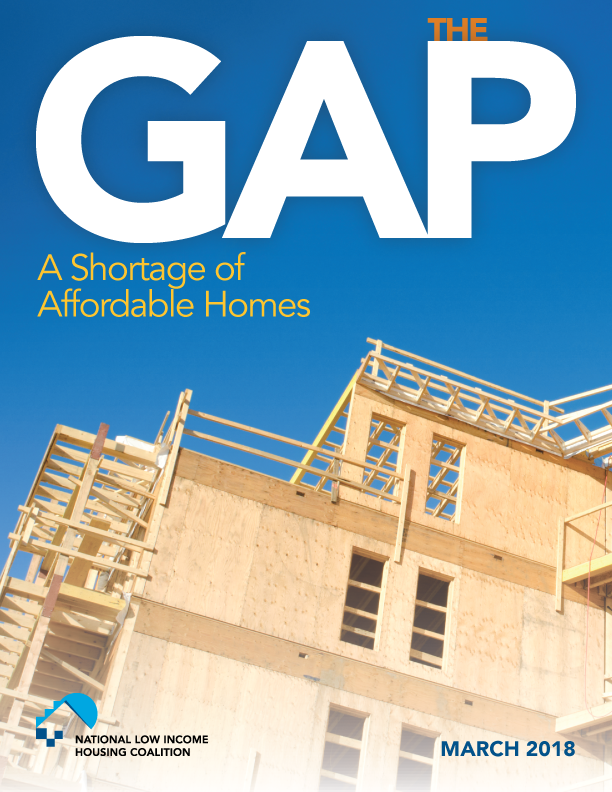NLIHC Releases Gap Report, Calls for Greater Investments to Address Massive Shortage of Affordable and Available Homes for the Lowest Income Households
Mar 26, 2018
 NLIHC released The Gap: A Shortage of Affordable Homes 2018 report on March 13. The report finds a shortage of 7.2 million affordable and available rental homes for extremely low income renter households whose incomes are less than either the poverty guideline or 30% of their area median income (AMI), whichever is higher. Seventy-one percent of extremely low income renter households are severely housing cost-burdened, spending more than half of their income on housing. They account for nearly three-quarters of all severely cost-burdened renters in the U.S. Eighty-four percent of extremely low income renter households who are severely cost-burdened are seniors or people with disabilities, or they are in the labor force. NLIHC released a new interactive online map with this year’s report.
NLIHC released The Gap: A Shortage of Affordable Homes 2018 report on March 13. The report finds a shortage of 7.2 million affordable and available rental homes for extremely low income renter households whose incomes are less than either the poverty guideline or 30% of their area median income (AMI), whichever is higher. Seventy-one percent of extremely low income renter households are severely housing cost-burdened, spending more than half of their income on housing. They account for nearly three-quarters of all severely cost-burdened renters in the U.S. Eighty-four percent of extremely low income renter households who are severely cost-burdened are seniors or people with disabilities, or they are in the labor force. NLIHC released a new interactive online map with this year’s report.
Extremely low income households continue to face by far the largest shortage of affordable and available rental housing of any income group. Nationwide, thirty-five affordable and available rental homes exist for every 100 extremely low income renter households. As a result, eight million extremely low income renter households are severely housing cost-burdened. By comparison, 2.1 million very low income renter households (incomes between 31% and 50% of AMI) and 700,000 low income renters (incomes between 51% and 80% of AMI) are severely cost-burdened. Fewer than 200,000 renter households with incomes above 80% of AMI are severely cost-burdened.
Extremely low income renter households face a shortage of affordable and available rental homes in every state and major metropolitan area. The supply ranges from only 15 affordable and available rental homes for every 100 extremely low income renter households in Nevada to 59 in Maine. Among the 50 largest metropolitan areas, the supply ranges from 10 affordable and available rental homes for every 100 extremely low income renter households in Las Vegas, NV, to 47 in Providence, RI.
Extremely low income households are more likely to be seniors, people with disabilities, or include children than other renter households. Forty-six percent of extremely low income renter households are seniors or people with disabilities, compared to 26% of other renters. Thirty-six percent of extremely low income renter households include children under the age of 18, compared to 31% of other renter households.
NLIHC calls for greater federal investments in housing programs targeted to the nation’s lowest income renters. These programs include the national Housing Trust Fund (HTF), the Housing Choice Voucher program, and public housing operating and capital funds. Finance reform of Fannie Mae and Freddie Mac provides an opportunity to significantly increase resources for the HFT. The HTF allocates money to states to distribute for the development or rehabilitation of housing affordable to extremely low income households. Previous housing finance reform proposals included $3.5 billion annually for the national HTF, which should be the starting point in any future reform proposals.
The Gap: A Shortage of Affordable Homes 2018 is available at: http://nlihc.org/gap